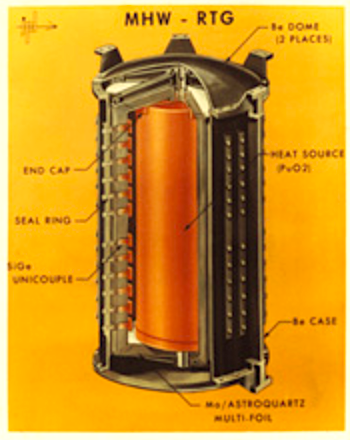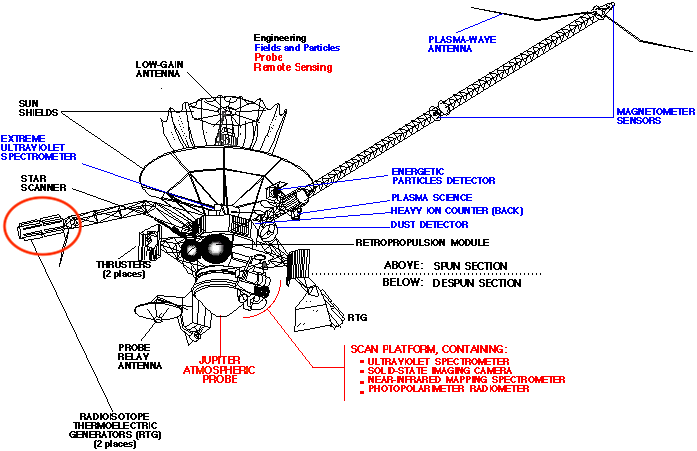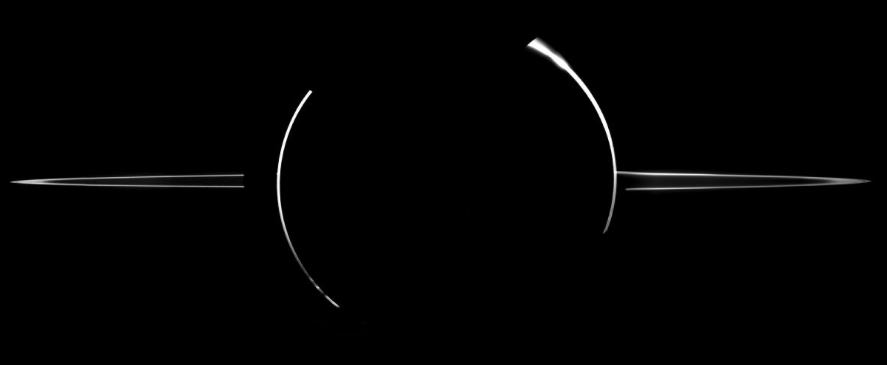Spacecraft I Have Known
Spacecraft I Have Known
Up close and personal — yet from afar
From 1981 to 1982, I worked on the
thermoelectric power systems
for NASA's Voyager and Galileo spacecraft.
Such deep-space missions operate too far away from the Sun to employ solar power.
Contents
1 Voyager Mission (1977 to Present)
1.1 RTGs and the Seebeck Effect
1.2 Where are they now?
1.3 Onboard computers
2 Little Known Facts
3 Galileo Mission (1989 to 2003)
4 What I Worked On (1981 to 1982)
4.1 My 1981 JPL slides
4.2 Time Travel
1 Voyager Mission (1977 to Present)
These machines are the most distant man-made objects in the universe and are a testament to
both NASA's awesome engineering capabilites and the role of robust robots instead of manned spaceflight.
Moreoever, they are still operating and now performing measurements that were not even conceived of during their original design,
some 40 years ago. My association with them came well after they had launched.
I was required to create a model of the degradation of their on-board power systems based on JPL thermal cycling data
(see Section 4).
The overall objective was to create a similar model for the planned Galileo mission (see Section 3).
Launched
in 1977: Voyager 2 on August 20 followed by Voyager 1 on September 5.

1.1 RTGs and the Seebeck Effect
Solar power is not an option because the distances from the sun are too great.
Therefore, an onboard power system called an RTG
(Radioisotope Thermoelectric Generator) is employed.
The RTGs are contained in three canisters that can be seen on
the end of the boom arm at the lower-left of the spacecraft (yellow oval in the image above).
The Voyager RTG's use a plutonium oxide nuclear reactor to produce heat which is
continuously converted into electrical current via the
Seebeck effect—essentially
a semiconducting thermocouple. The Seeback material used in
the Voyager spacecraft is a doped Si-Ge semiconducting alloy
— not single-crystal
silicon but amorphous silicon, similar to that used in solar panels.
 The RTG is actually like a tiny solar panel with its own Lilliputian `sun' provided by the mini nuclear reactor.
The original power output was about 500 watts. Think about it. That's equivalent to just 8
household 60-watt light bulbs!
How do you communicate with 10 light bulbs that are now about 20 billion km from Earth?
The answer is, you need a hella big EYE. That special eye is called the NASA
Deep Space Network (DSN).
Find out its bit-serial transmission rate in Section 2.
You'll be underwhelmed.
By January 2015, the available electrical power on Voyager 1 had dropped to 255 watts and to 258 watts for Voyager 2
because of the precipitation effects. As described below, this is close the 300 watt value that my model predicted.
In addition, JPL has been conserving power consumption in recent years, realizing the Voyagers could now do many unplanned measurements
as they leave our solar system.
The later generation of RTG power systems,
like those on the Galileo misson (see Section 3),
used lanthanum chalcogenides as the thermoelectric semiconductor.
The RTG is actually like a tiny solar panel with its own Lilliputian `sun' provided by the mini nuclear reactor.
The original power output was about 500 watts. Think about it. That's equivalent to just 8
household 60-watt light bulbs!
How do you communicate with 10 light bulbs that are now about 20 billion km from Earth?
The answer is, you need a hella big EYE. That special eye is called the NASA
Deep Space Network (DSN).
Find out its bit-serial transmission rate in Section 2.
You'll be underwhelmed.
By January 2015, the available electrical power on Voyager 1 had dropped to 255 watts and to 258 watts for Voyager 2
because of the precipitation effects. As described below, this is close the 300 watt value that my model predicted.
In addition, JPL has been conserving power consumption in recent years, realizing the Voyagers could now do many unplanned measurements
as they leave our solar system.
The later generation of RTG power systems,
like those on the Galileo misson (see Section 3),
used lanthanum chalcogenides as the thermoelectric semiconductor.
1.2 Where are they now?
1.3 Onboard computers
The Voyager mission was officially approved in
May 1972.
At that time, hand-held calculators were the only computers available to the mass consumer market.
A moment's reflection quickly leads to questions about the type of computer control used on the Voyager.
There are three types of computers
on the Voyager spacecraft and there are two of each kind for redundancy.
- Computer Command System (CCS): 18-bit word, interrupt type processors (2) with 4096 words each of plated wire, non-volatile memory.
- Flight Data System (FDS): 16-bit word machine (2) with modular memories and 8198 words each
- Attitude and Articulation Control System (AACS): 18-bit word machines (2) with 4096 words each.
Each processor uses a 12-bit wide word with 64 instructions.
They were built using custom TTL and discrete logic, manufactured by General Electric to JPL specifications.
Remarks that they employed either of the
RCA 1802 or the
Intel 8008
microprocessor apparently have
no factual basis.
2 Little Known Facts
- The Voyager spacecraft numbers (1 and 2) are the reverse of their launch order.
- Voyager 2 was launched first (Aug 20) but on Dec 15, 1977 Voyager 1 (launched Sep 5) overtook it while they were in the asteroid belt.
- In 1998 Voyager 1 surpassed the distance record held by the (now defunct)
Pioneer 10 spacecraft launched in 1972
The difference comes from the greater velocity of Voyager due to gravitational sling-shot effects
- Deep spacecraft cannot use solar power. See Section 1.1
- Transmission rate with the DSN is 160 baud. Probably the slowest modem you ever used was 300 baud (if you ever used a modem)
- They each have 16 hydrazine thrusters for attitude and articulation control
- They have used up a little over half their 100 kg of propellant as of April 2006
- What we Earthlings look like from deep space, viz., 40.5 AU on Feb 14, 1990
- The gold-plated copper plaque on Voyager
differs from the Pioneer plaque
in that it is a circular disk with recorded tracks on one side (vinyl LP style)
- Unlike the Pioneer plaque, the Voyager plaque does not provide any information about the size of humans relative to the
spacecraft (if it were ever to be captured by intelligent exo-solar life forms). This strikes me as a gross oversight
- The diameter of the dish antenna on the Pioneer is 2.74 meters (approx. 9 feet) while the Voyager dish diameter is about 1/3rd bigger at
3.7 meters (approx. 12 feet or twice the height of an average human)
-
Both Voyager 1 and
Voyager 2 have Twitter accounts
-
NASA doesn't have enough nuclear fuel for its future deep space missions (Dec 13, 2018)
3 Galileo Mission (1989 to 2003)
Launched
October 18, 1989 after being shelved for many years due to reductions in NASA funding.
3.1 Galaileo RTGs
The RTG power system employed a doped La-Cu-O thermoelectric semiconductor. The
RTG's are located in the two canisters on the left side of the spacecraft.
 The Galileo spacecraft's 14-year
odyssey
ended on Sunday, Sept. 21, 2003 when it
passed into Jupiter's shadow and disintegrated in the planet's dense atmosphere
at 11:57 a.m. Pacific Daylight Time. The Deep Space Network (DSN) tracking station in
Goldstone, California, received the last signal at 12:43:14 PDT: the delay being due
to the speed of light.
The Galileo spacecraft's 14-year
odyssey
ended on Sunday, Sept. 21, 2003 when it
passed into Jupiter's shadow and disintegrated in the planet's dense atmosphere
at 11:57 a.m. Pacific Daylight Time. The Deep Space Network (DSN) tracking station in
Goldstone, California, received the last signal at 12:43:14 PDT: the delay being due
to the speed of light.
3.2 Rings of Jupiter
 Galileo captured enhanced images Jupiter's faint rings by using the Sun as backlighting.
This image was processed using the original orange and violet images taken by Voyager 2 on July 11 in 1979,
converting those to grayscale, and combining them with grayscale images taken by Galileo on
November 9, 1997.
Galileo captured enhanced images Jupiter's faint rings by using the Sun as backlighting.
This image was processed using the original orange and violet images taken by Voyager 2 on July 11 in 1979,
converting those to grayscale, and combining them with grayscale images taken by Galileo on
November 9, 1997.
4 What I Worked On (1981 to 1982)
Syncal Corporation was a small consulting company located in Sunnyvale,
California, that had contracts with NASA and JPL to develop the RTG
thermoelectric materials for NASA's deep-space missions like, Voyager and Galileo. Syncal was
later bought by Thermo Electron Inc.
in 1982 (now Thermo Fisher Scientific).
The first task I was given at Syncal, was to analyze thermal stability data from the Voyager
RTG. It was during that project that I discovered the stability of the Voyager
Si-Ge thermoelectric material was controlled by a form of
soliton precipitation.
Here's the 1982 IEEE paper (PDF) that discusses the mechanism in detail.
Over a very long period of time, the thermal gradient eventually
drives the Ge out of solution. Remarkably, I was able to draw heavily on certain
mathematical results from my Ph.D. thesis—which had nothing to do with either
RTGs or the Seebeck effect.
4.1 My 1981 JPL slides
These are the slides I used in a presentation to JPL. Clearly, we're talking
pre-Powerpoint days. Me cajoling Syncal into purchasing an IBM PC, rather than continuing to buy VAX 11-780 time,
was considered to be something of an exotic gamble.
The payoff was that Fig. 7 (in a different form) could be used to predict the lifetime of Voyager RTGs.
It came to about 35 years after launch.
JPL, being very clever, have managed to extend the RTG operational lifetime even further by powering down any
unnecessary data acquisition subsystems.
Table 1: My 1981 presentation slides for JPL
4.2 Time Travel
This project also had a peculiar sense of time-travel about it — along
the lines of back to the future. We (in 1981) wanted to affect change in
RTG materials from Voyager's past (launched in 1977) in order to get to
Galileo's future (launched in 1989).
Any problems that I might uncover regarding the Voyager power system could
not be corrected on that spacecraft: it was much too late for that.
They could only be applied to the construction of the future Galileo spacecraft. As a
side-effect, however, the Voyager data did enable me to make a prediction about its
future lifetime — something on the order of 35 years
(now well exceeded thanks to some clever JPL reconfiguration commands).
In case you are wondering, the Voyager data that I analyzed did not come from
the spacecraft in real time. Rather, it had been collected from laboratory ovens
at JPL well prior to the launch of the Voyager spacecraft.
Samples of Voyager thermoelectric material had been subjected to
accelerated thermal cycling. JPL wanted to use that thermal-cycling data
in selecting the next generation of thermoelectric material for the
Galileo RTGs.
I was the first person to understand what those Voyager data were trying to tell us.


















